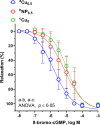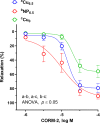Dietary supplementation with copper nanoparticles influences the markers of oxidative stress and modulates vasodilation of thoracic arteries in young Wistar rats
- PMID: 32084205
- PMCID: PMC7034852
- DOI: 10.1371/journal.pone.0229282
Dietary supplementation with copper nanoparticles influences the markers of oxidative stress and modulates vasodilation of thoracic arteries in young Wistar rats
Abstract
We aimed to study the physiological effects of diet supplemented with copper (Cu) nanoparticles (NPs). During the eight weeks of the experiment, young Wistar rats (at seven weeks of age, n = 9) were supplemented with 6.5 mg of Cu either as NPs or carbonate salt (Cu6.5). A diet that was not supplemented with Cu served as a negative control (Cu0). The impact of nano Cu supplementation on lipid (reflected as thiobarbituric acid reactive substances-TBARS) and protein peroxidation (thiol and carbonyl groups) in blood plasma as well as the influence on the vasodilatory mechanism(s) of isolated rat thoracic arteries were studied. Supplementation with Cu enhanced lipid peroxidation (TBARS) in NP6.5 (x2.4) and in Cu6.5 (x1.9) compared to the negative control. Significant increase in TBARS was also observed in NP6.5 (x1.3) compared to the Cu6.5 group. The level of thiol groups increased in NP6.5 (x1.6) compared to Cu6.5. Meanwhile, significant (x0.6) decrease was observed in the Cu6.5 group compared to the negative control. Another marker of protein oxidation, carbonyl groups increased in NP6.5 (x1.4) and Cu6.5 (x2.3) compared to the negative control. However significant difference (x0.6) was observed between NP6.5 and Cu6.5. Arteries from Cu supplemented rats exhibited an enhanced vasodilation to gasotransmitters: nitric oxide (NO) and carbon monoxide (CO). An enhanced vasodilation to NO was reflected in the increased response to acetylcholine (ACh) and calcium ionophore A23187. The observed responses to ACh and CO releasing molecule (CORM-2) were more pronounced in NP6.5. The activator of cGMP-dependent protein kinases (8-bromo-cGMP) induced similar vasodilation of thoracic arteries in NP6.5 and Cu0 groups, while an increased response was observed in the Cu6.5 group. Preincubation with the inducible nitric oxide (iNOS) synthase inhibitor- 1400W, decreased the ACh-induced vasodilation in NP6.5, exclusively. Meanwhile the eicosanoid metabolite of arachidonic acid (20-HETE) synthesis inhibitor-HET0016, enhanced vasodilation of arteries from Cu0 group. In conclusion, this study demonstrates that supplementation with nano Cu influences oxidative stress, which further has modified the vascular response.
Conflict of interest statement
The authors have declared that no competing interests exist.
Figures







References
-
- Majewski M, Kozlowska A, Thoene M, Lepiarczyk E, Grzegorzewski WJ. Overview of the role of vitamins and minerals on the kynurenine pathway in health and disease. J Physiol Pharmacol. 2016; 67: 3–19. - PubMed
-
- Wang T, Yu WG, Powell WS. Formation of monohydroxy derivatives of arachidonic acid, linoleic acid, and oleic acid during oxidation of low density lipoprotein by copper ions and endothelial cells. J Lipid Res. 1992; 33: 525–537. - PubMed
Publication types
MeSH terms
Substances
LinkOut - more resources
Full Text Sources
Medical

